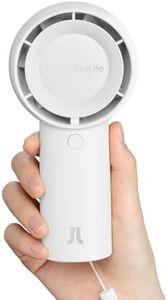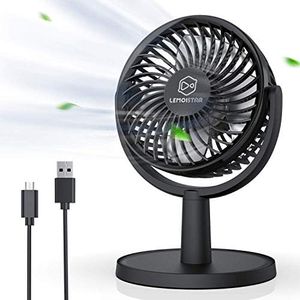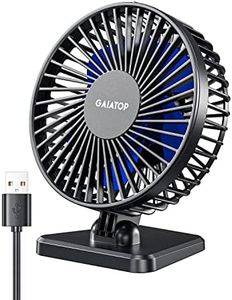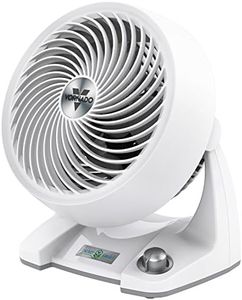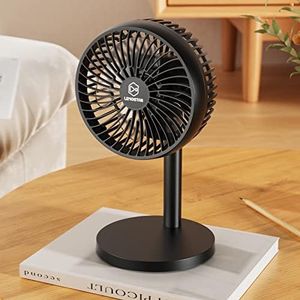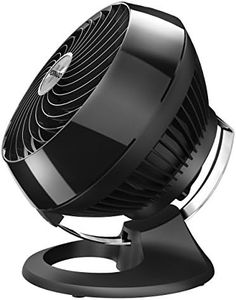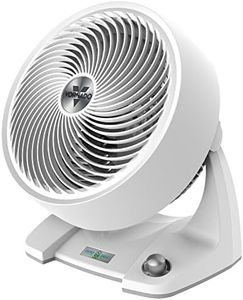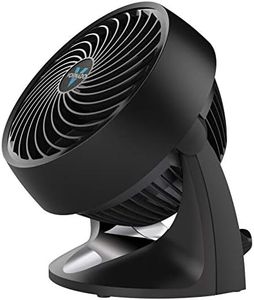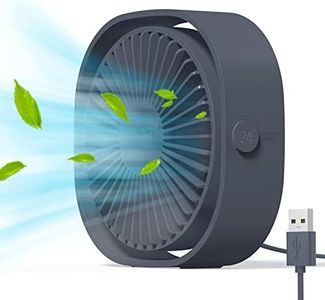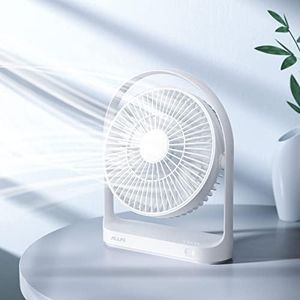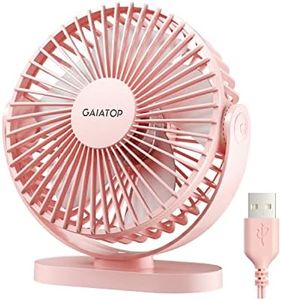We Use CookiesWe use cookies to enhance the security, performance,
functionality and for analytical and promotional activities. By continuing to browse this site you
are agreeing to our privacy policy
10 Best Small Desk Fans
From leading brands and best sellers available on the web.Recommended lists
Buying Guide for the Best Small Desk Fans
Selecting the right small desk fan can significantly improve your comfort while working or relaxing at your desk. Since desk fans come in a variety of shapes, sizes, and feature sets, it's helpful to think about where you'll use it, noise tolerance, airflow needs, and any extra features that might make your day easier. Understanding the key specs will help you make an informed choice that matches your personal needs and work environment.Size and PortabilityThis refers to the dimensions and weight of the fan. It's important because a bulky or heavy fan might not fit comfortably on your desk or might be difficult to move. Desk fans are typically divided into very small (less than 6 inches wide, good for personal use and portability), medium (6-10 inches, good for slightly larger coverage), and large (above 10 inches, offering more airflow but taking up more space). Assess your desk space and whether you'll want to move the fan between rooms or use it in different locations; this will help you decide what size and weight works best.
Power SourceSmall desk fans usually run on either USB, batteries, or traditional wall outlets. This is crucial because your access to power will determine which is most convenient. USB-powered fans are ideal for desks with computers or laptops, while battery-operated fans offer true portability and are handy where plugs aren't accessible. Fans that use wall outlets are good if you need longer or stronger sessions without worrying about charging. Think about your usual workspace setup and pick the option that fits in seamlessly with your daily routine.
Speed SettingsMost desk fans offer a selection of speed settings, generally from a simple on/off switch to two or three different speeds. Speed settings affect both airflow and noise, so being able to adjust this can suit changing temperatures and personal comfort. Lower speeds are quieter and use less power but provide less airflow, while higher speeds are stronger but can be noisy. Consider if you need variable speeds for flexibility, or if a single gentle breeze is sufficient for your space.
Noise LevelNoise level describes how much sound the fan produces during operation. For a desk fan, a low noise level is particularly important for environments like offices or study spaces where quiet is valued. Fans are often described as whisper-quiet, moderate, or loud. Whisper-quiet fans tend to have smaller blades or lower speeds, suitable for libraries or nighttime use; moderate ones are usually fine in most offices; louder fans might be better for places where background noise is less of a concern. If you'll be on calls or need to concentrate, aim for a quieter model.
OscillationOscillation means whether the fan head can move side-to-side, helping to distribute air over a wider area instead of in just one direction. This is valuable if multiple people will use the air flow or if you want to refresh a larger portion of your workspace. Fans may not oscillate at all, may oscillate within a certain range (like 90 or 180 degrees), or allow the head to tilt vertically as well. If you want targeted air just for yourself, non-oscillating might be fine; for broader cooling, look for an oscillating feature.
Blade vs. Bladeless DesignSome fans have traditional blades, while others use a bladeless design for safety and easier cleaning. Bladeless fans are generally quieter, safer around pets and children, and often have a modern look, but can cost more and may offer slightly different airflow patterns. Standard bladed fans are classic, offer strong direct airflow, and are usually simpler. Consider whether safety, style, or airflow pattern matter most for your particular needs.
AdjustabilityAdjustability covers how much you can change the angle or direction of the fan's airflow, either by tilting the head or adjusting its height or base. Good adjustability ensures you can direct cool air right where you need it, which is especially important if you'll be using the fan for different tasks or positions throughout the day. If you'll mostly sit in one spot, minimal adjustability might suffice, but if your setup changes or you'll share the fan, look for maximum flexibility.
Additional FeaturesExtra features like timers, remote controls, built-in night lights, or even aroma diffusers can enhance the fan's usefulness. While not essential, these can make your desk fan more convenient or enjoyable. For example, a timer is helpful if you like to fall asleep with the fan on, while a night light can help in darker rooms. Think about which of these extras might actually fit into your routine before letting them influence your decision.
